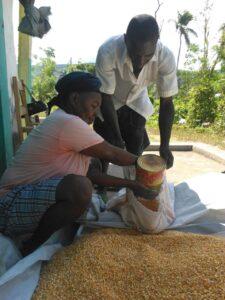From Crisis Response to Building Resiliency in Haiti
It’s been four months since Hurricane Matthew, a category 4 storm, ravaged Southern Haiti leaving in its wake destroyed communities and farmland. Southern Haiti, which is known as Haiti’s breadbasket, was brought to it knees and large parts of the country were at risk of famine. The hurricane hit less than a month before harvest, a harvest that would have sustained local communities and people living farther afield in other parts of Haiti until the next harvest in May.
In the days and months after the hurricane, an estimated 1.5 million people in Southern Haiti were deemed at risk of starvation without immediate support. Since then, that number has been reduced to 400,000.
Because of our deep roots in Haiti, and with the generosity of our supporters, Grassroots International immediately raised emergency funds to support our partners recovery efforts in the most devastated areas in Southern Haiti, and also farther out in Northern Haiti where sustained winds and rain led to severe flooding and destruction of homes and farms. In doing so, Grassroots International respected the call for a Haitian-led recovery effort articulated by Haitian social movements and the Government of Haiti to avoid mistakes made by relief agencies after the 2010 earthquake.
 While the work of our partners continues in Haiti, we have learned that because of timely support, they were able to feed, clothe, or house hundreds of families. And, they’ve started the arduous process of clearing and rehabilitating farmland for planting. The work is slow, but it’s good, purposeful work. Below are pictures taken by our partner, Haitian Platform to Advocate Alternative Development (PAPDA) during a distribution of black beans and corn to local farmers in Southern Haiti. Beans, a staple of Haitian cuisine, provide much-needed nutritional content (protein and fiber) at a relatively low cost when compared with animal protein. And corn, served in various forms including polenta and porridge, is a go-to low-cost carb.
While the work of our partners continues in Haiti, we have learned that because of timely support, they were able to feed, clothe, or house hundreds of families. And, they’ve started the arduous process of clearing and rehabilitating farmland for planting. The work is slow, but it’s good, purposeful work. Below are pictures taken by our partner, Haitian Platform to Advocate Alternative Development (PAPDA) during a distribution of black beans and corn to local farmers in Southern Haiti. Beans, a staple of Haitian cuisine, provide much-needed nutritional content (protein and fiber) at a relatively low cost when compared with animal protein. And corn, served in various forms including polenta and porridge, is a go-to low-cost carb.
In addition to participating in the recovery effort, our partners are also working hard to develop and implement climate change adaptation and mitigation strategies that will build resiliency in the communities where they work. As we have learned over the last 15 years, though countries in the Global South have contributed very little to climate change, they stand to bear the brunt of climate disruption — rising sea levels, frequent and more severe storms, droughts, and the list goes on.
Nowhere is this truer than in Haiti, situated in the middle of the Caribbean Sea’s hurricane belt. For our partners in Haiti, climate change adaptation and mitigation strategies mean promotion of alternative and renewable fuel/energy, propagation of local drought resistant seed varieties, agroecology (to feed communities, rebuild forest cover and cool the planet) and building storm resistant structures. This is a tall order, but those of us who support Haiti and progressive social movements there must see and seize this opportunity to move Haiti from crisis response to resiliency in the face of climate change.
